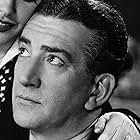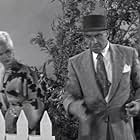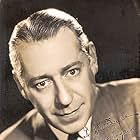IMDb RATING
7.1/10
5.1K
YOUR RATING
A crusading district attorney persuades a clip joint hostess to testify against her mobster boss after her innocent sister is accidentally murdered during one of his unsavory parties.A crusading district attorney persuades a clip joint hostess to testify against her mobster boss after her innocent sister is accidentally murdered during one of his unsavory parties.A crusading district attorney persuades a clip joint hostess to testify against her mobster boss after her innocent sister is accidentally murdered during one of his unsavory parties.
- Awards
- 1 win & 1 nomination total
- Directors
- Writers
- All cast & crew
- Production, box office & more at IMDbPro
Storyline
Did you know
- TriviaBased on the life of gangster Lucky Luciano, who was finally imprisoned when some of the prostitutes who worked in one of his brothels, tired of the beatings and maltreatment meted out by him, informed on him to the police. Luciano was prosecuted by Thomas E. Dewey, who infamously did not beat Harry S. Truman.
- Quotes
Mary Dwight Strauber: I'll get you, even if I have to crawl back from the grave to do it!
- SoundtracksMy Silver Dollar Man
(1937) (uncredited)
Music by Harry Warren
Lyrics by Al Dubin
Sung by Rosalind Marquis
Featured review
"Marked Woman" was banned on it's original release here in Australia then abruptly withdrawn at the last moment from it's initial television screening here in 1966. Why all the fuss? Well it's because of those female leads playing "hostesses" in a "clip joint" are obviously playing prostitutes! Shock! And in a film from 1937!
This film followed hot on the heels of the sensational and newsbreaking 1936 trial of mobster Lucky Luciano who was convicted on the evidence of the prostitutes who worked for him. This was the sort of material ("torn from the headlines") that was the staple and was very much a part of the house style of 1930's Warners - gritty, hard boiled, tough stories concerning the working person facing the depression. At the end of the opening credits there is a title card disclaiming any resemblance to persons real or otherwise in the film. This was rarely if ever stated so strongly in films of this period. Warners were obviously very conscious about being seen to be not capitalizing on such a headline event so soon after - which they were!
Simple sets abound reflecting the obsession that Warners had with economy - even the nightclub is rather plain with not too many long shots to expose too much. This nightclub over at RKO would have had a distinctly chic Art Deco look as per the trademark of that studios Art Director, and the whole production is also in stark contrast to the lavish Crawford and Shearer vehicles over at MGM.
This film is late in Davis' "early period" - one which I find fascinating with it's odd mix of narrative concerning women and crime. It is also a very interesting vehicle of Humphrey Bogart still years off from the super-stardom he found from "High Sierra" in 1941. His role is very much the reflection of the censors requirement from 1934 that the law makers be glorified and not the law breakers as was very much the case and staple of pre-1934 Warners output. His speech as District Attorney in court has an abundance of force and conviction.
Other players in the film to my mind fit like a glove. Eduardo Ciannelli is suitably creepy and sleazy as the crime boss. Lola Lane, Rosalind Marquis (both giving us two nice Warren and Dubin numbers in the nightclub), Mayo Methot (soon to be Mrs Bogart in real life in what was a very stormy union) and Isabel Jewell (the perfect little gold-digger) portray with the toughness required and as the other "marked women" trapped in a life on the wrong side of the law. Costuming reflects perfectly their "class" in spite of their lucrative profession.
"Marked Woman" also closely followed the landmark court case between a very unhappy Davis (trapped in what was very much a man's studio) and Warners over the crummy scripts she was repeatedly presented in spite of her landmark performances in "Of Human Bondage" ('34) at RKO and "The Petrified Forest" ('35). After being off the screen for almost a year she lost the case and came back humbly with the studio relieved to have their "upcoming" leading female star back in action (tempramental star Kay Francis career at Warners was winding down by this stage) and eventually giving her more meaty and suitable parts like "Marked Women" with their really coming to the party in giving her "Jezebel" in 1938.
"Jezebel" was the doorway for Davis' "mature" phase for it was the director of "Jezebel" (and subsequent vehicles "The Letter" (40) and "The Little Foxes" (41)) William Wyler was able to tame her and provide much assistance in maturing her performances. Simultaneously Warners became a outfit turning out extremely polished vehicles and one of the champions of the "Womens Picture" through the 1940's.
We are very fortunate in the Australian National Film and Sound Archive having a good 16mm copy of the film which we will be screening at our film society this year. There's nothing like seeing a film like this in it's intended environment - the big screen!
Enter a suspended state of disbelief and enjoy this entertaining and gritty melodrama from Hollywood's golden age!
This film followed hot on the heels of the sensational and newsbreaking 1936 trial of mobster Lucky Luciano who was convicted on the evidence of the prostitutes who worked for him. This was the sort of material ("torn from the headlines") that was the staple and was very much a part of the house style of 1930's Warners - gritty, hard boiled, tough stories concerning the working person facing the depression. At the end of the opening credits there is a title card disclaiming any resemblance to persons real or otherwise in the film. This was rarely if ever stated so strongly in films of this period. Warners were obviously very conscious about being seen to be not capitalizing on such a headline event so soon after - which they were!
Simple sets abound reflecting the obsession that Warners had with economy - even the nightclub is rather plain with not too many long shots to expose too much. This nightclub over at RKO would have had a distinctly chic Art Deco look as per the trademark of that studios Art Director, and the whole production is also in stark contrast to the lavish Crawford and Shearer vehicles over at MGM.
This film is late in Davis' "early period" - one which I find fascinating with it's odd mix of narrative concerning women and crime. It is also a very interesting vehicle of Humphrey Bogart still years off from the super-stardom he found from "High Sierra" in 1941. His role is very much the reflection of the censors requirement from 1934 that the law makers be glorified and not the law breakers as was very much the case and staple of pre-1934 Warners output. His speech as District Attorney in court has an abundance of force and conviction.
Other players in the film to my mind fit like a glove. Eduardo Ciannelli is suitably creepy and sleazy as the crime boss. Lola Lane, Rosalind Marquis (both giving us two nice Warren and Dubin numbers in the nightclub), Mayo Methot (soon to be Mrs Bogart in real life in what was a very stormy union) and Isabel Jewell (the perfect little gold-digger) portray with the toughness required and as the other "marked women" trapped in a life on the wrong side of the law. Costuming reflects perfectly their "class" in spite of their lucrative profession.
"Marked Woman" also closely followed the landmark court case between a very unhappy Davis (trapped in what was very much a man's studio) and Warners over the crummy scripts she was repeatedly presented in spite of her landmark performances in "Of Human Bondage" ('34) at RKO and "The Petrified Forest" ('35). After being off the screen for almost a year she lost the case and came back humbly with the studio relieved to have their "upcoming" leading female star back in action (tempramental star Kay Francis career at Warners was winding down by this stage) and eventually giving her more meaty and suitable parts like "Marked Women" with their really coming to the party in giving her "Jezebel" in 1938.
"Jezebel" was the doorway for Davis' "mature" phase for it was the director of "Jezebel" (and subsequent vehicles "The Letter" (40) and "The Little Foxes" (41)) William Wyler was able to tame her and provide much assistance in maturing her performances. Simultaneously Warners became a outfit turning out extremely polished vehicles and one of the champions of the "Womens Picture" through the 1940's.
We are very fortunate in the Australian National Film and Sound Archive having a good 16mm copy of the film which we will be screening at our film society this year. There's nothing like seeing a film like this in it's intended environment - the big screen!
Enter a suspended state of disbelief and enjoy this entertaining and gritty melodrama from Hollywood's golden age!
- mb_cine_films
- Feb 28, 2007
- Permalink
Everything New on Max in December
Everything New on Max in December
Looking for something different to add to your Watchlist? Take a peek at what movies and TV shows are coming to streaming this month.
- How long is Marked Woman?Powered by Alexa
Details
- Release date
- Country of origin
- Official site
- Language
- Also known as
- La mujer marcada
- Filming locations
- Times Square, Manhattan, New York City, New York, USA(opening establishing shot)
- Production companies
- See more company credits at IMDbPro
- Runtime1 hour 36 minutes
- Color
- Sound mix
- Aspect ratio
- 1.37 : 1
Contribute to this page
Suggest an edit or add missing content









































